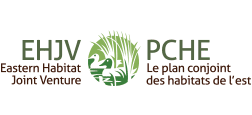The Birds
Waterfowl
Waterfowl include ducks, geese and swans and are birds that frequent water. These birds have flat bills and webbed feet and need aquatic habitats such as wetlands, rivers, lakes, streams or oceans to survive. Waterfowl populations began to plummet across North America in the 1970s, but many populations are now recovering due to successful investment in conservation. The EHJV has identified 6 priority species of waterfowl for conservation action.
Priority Waterfowl Species
| American Black Duck | Mallard |
| Goldeneye (Common and Barrow’s) | Wood Duck |
| Common Eider |
Landbirds
Landbirds include warblers, thrushes, sparrows, finches, hummingbirds, flycatchers and raptors. These birds occupy mainly terrestrial habitats and include grassland birds (e.g., Bobolink), aerial insectivores (e.g., Olive-sided Flycatcher and Bank swallow) and forest birds (e.g., Scarlet Tanager). Many land bird species are declining in Canada with aerial insectivores having declined by 59 per cent and grassland birds by 57 per cent since the 1970s.
Priority Landbird Species
Waterbirds
Waterbirds are those birds that are ecologically dependent on wetlands and include rails, coots, terns, pelicans, auks, grebes and cormorants. Many waterbird species, such as Common Loon and Least Bittern, are listed as Threatened under Canada’s Species at Risk Act. Waterbirds are important components of marine (e.g., Atlantic Puffin) and freshwater environments (e.g., Virginia Rail) and have also benefited from wetland conservation actions.
Priority Waterbirds Species
Shorebirds
Since the 1970s, shorebirds – sandpipers, plovers, avocets, oystercatchers and phalaropes – have declined by 40 per cent in Canada. Eighty-one of the 217 recognized species occur in the Americas for all or part of their lifecycle and 52 species breed in North America. Examples of shorebirds in the EHJV include the endangered Piping Plover, endangered Red Knot (rufa) and the Semipalmated Sandpiper
Priority Shorebirds Species
Wetland Species

1 – Landbirds
Landbirds have a mainly terrestrial lifecycle and depend on varied habitats including forests, barrens, wetlands, forested wetlands, and riparian areas for parts of their lifecycle. There are 11 priority landbird species in the Eastern Habitat Joint Venture (EHJV) including Rusty Blackbird, a species at risk.
2 – Shorebirds
Most species of shorebirds depend on coastal areas and inland wetlands for breeding, staging, migration and wintering. Shorebirds have declined by 40% in Canada. Priority shorebird species for the EHJV: Red knot (rufa) a species at risk, and Semipalmated Sandpiper.
3 – Aerial Insectivores
Aerial insectivores, a sub-group of landbirds, feed by catching insects inflight and use, along with other habitats, open to semi-open wetlands, swamps and riparian habitats for food. Priority EHJV aerial insectivores: Bank Swallow and Olive-sided Flycatcher, both listed as species
at risk.
4 – Waterfowl
Waterfowl are dependant on wetlands and have benefited from EHJV wetland and coastal habitat conservation projects delivered under the North American Waterfowl Management Plan. EHJV priority species: American Black Duck, Mallard, Common Goldeneye, Barrow’s Goldeneye, Wood Duck and Common Eider.
5 – Waterbirds
Waterbirds depend almost entirely on wetlands during their lifecycle and have benefited from wetland conservation projects in the EHJV. Many are elusive, breed in remote areas and are difficult to monitor. EHJV priority waterbird species: Common Tern, Black Tern and Virginia Rail.
6 – Grassland Birds
Grassland birds, a sub-group of landbirds, have declined by 57% in Canada and depend on the upland habitat, native grasslands and agricultural landscapes. Priority EHJV grassland species: Short-eared Owl and Bobolink, both listed as species at risk.
For more information, see the 2019 State of Canada’s Birds Report.

